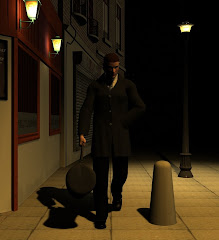 The Easter story has always been the best in the Bible. There is, as mentioned below, death and rebirth. There's blood and sacrifice and suffering and blood. There's a great deal of blood, in fact. It's no wonder that Mel Gibson, in his Passion of the Christ, was able to make a previously unseen link between the Gospels and Quentin Tarentino.
The Easter story has always been the best in the Bible. There is, as mentioned below, death and rebirth. There's blood and sacrifice and suffering and blood. There's a great deal of blood, in fact. It's no wonder that Mel Gibson, in his Passion of the Christ, was able to make a previously unseen link between the Gospels and Quentin Tarentino.More importantly the Easter story also has a wide range of human actions. Mostly of the worst kind. There's the fickleness of crowds, the feebleness of conciliatory politicians. There are crises of faith everywhere. There's even a crisis of faith from the son of God, for heaven's sake; an astonishing passage even in a text which breaks many rules of what you should do when establishing a new religion. Above all else, there are betrayals. Judas', of course. Even though Jeffrey Archer is currently peddling line, I still believe that Judas has been slightly harshly treated by posterity. He was basically a cipher after all, taking Jesus to a death which was necessary for human salvation. Besides, Judas wasn't alone. Everyone let Jesus down ultimately.
The Easter story has also inspired the best art. There are some decent images of Jesus' birth. But all painters of the Nativity succumb, to one degree or another, to an impulse known as "Ooooh, it's a liddle baby!" This sort of tweeness isn't possible in the cynicism leading up to the Crucifixion, the brutality of the event and the miracle afterwards. Pieter Brugel lashed out at the crowds in The Procession To Calvary, his astonishing depiction of the Crucifixion treated as a Sunday outing. (Pontificated on in more detail in an earlier posting.) Caravaggio played to his strengths too, showing a dark and disturbing Flagellation Of Christ by two satanic guards. Blood is missing from Andrea Mantegna's painting but only because it's all already drained from The Dead Christ; Jesus is as grey as a crypt, four gruesome holes in his body. There isn't, in fact, much optimism in most of the Easter paintings. The focus is on what we lost, not on what we've supposedly gained.
Especially in one of the defining images, Leonardo's The Last Supper. The last stage in Jesus' fatalistic trudge towards his death. The painting captures perfectly the poignancy of the event; and it anticipates the betrayals to come. Leonardo was superb at the precisely ordered group portrait and here it becomes more than an academic demonstration. Jesus sits at the head of the table and the centre of the picture, surrounded by his disciples. He sits alone, however. Those nearest him are leaning or even recoiling away. The ones on the fringes are staring at him, gossiping amongst themselves; but nobody is addressing him directly. He has lost them and he knows this. His face downturned, he spreads his hands out hopelessly. Jesus seems to be asking, what more can I do for you? Die for them – and Leonardo paints this as if it means he's failed.
It's a very human story, the Easter one. There's no constant interaction with a booming voice from the heavens. There's just a religious leader, a little too perfect for his or any other time. One who's betrayed and finally, torn apart by pain, seems to lose his own faith. It's a tragic tale too, the triumph of malice and avarice, and sometimes the Resurrection almost feels like a happy ending tacked on rather artificially. That's not the proper interpretation, I know, but maybe it's an excusable one. Because we do betray our saints and we do excuse our crooks. (Hello Mr Archer and pass on my regards to your new best mate, the Pope.) We do fail because of pettiness or greed or cowardice. We do it all the time and that's probably why somebody had to get himself nailed to a cross to redeem us.

1 comment:
That IS entersting indeed :)
Post a Comment